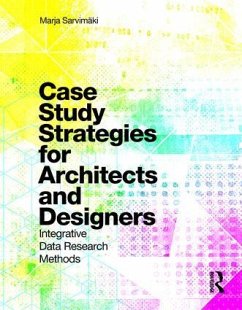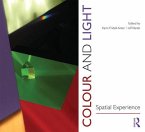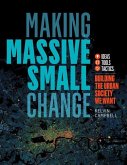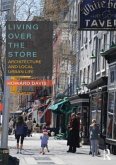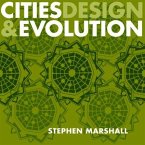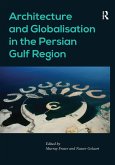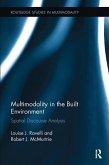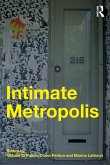- Broschiertes Buch
- Merkliste
- Auf die Merkliste
- Bewerten Bewerten
- Teilen
- Produkt teilen
- Produkterinnerung
- Produkterinnerung
Case Study Strategies for Designers explains methods in evidence-based design, also called practice-based research, to show you the value of research to your designs.
Andere Kunden interessierten sich auch für
![Colour and Light Colour and Light]() Colour and Light103,99 €
Colour and Light103,99 €![Making Massive Small Change Making Massive Small Change]() Kelvin CampbellMaking Massive Small Change33,99 €
Kelvin CampbellMaking Massive Small Change33,99 €![Living Over the Store Living Over the Store]() Howard DavisLiving Over the Store63,99 €
Howard DavisLiving Over the Store63,99 €![Cities Design and Evolution Cities Design and Evolution]() Stephen MarshallCities Design and Evolution122,99 €
Stephen MarshallCities Design and Evolution122,99 €![Architecture and Globalisation in the Persian Gulf Region. Edited by Murray Fraser, Nasser Golzari Architecture and Globalisation in the Persian Gulf Region. Edited by Murray Fraser, Nasser Golzari]() Nasser GolzariArchitecture and Globalisation in the Persian Gulf Region. Edited by Murray Fraser, Nasser Golzari68,99 €
Nasser GolzariArchitecture and Globalisation in the Persian Gulf Region. Edited by Murray Fraser, Nasser Golzari68,99 €![Multimodality in the Built Environment Multimodality in the Built Environment]() Louise J. RavelliMultimodality in the Built Environment78,99 €
Louise J. RavelliMultimodality in the Built Environment78,99 €![Intimate Metropolis Intimate Metropolis]() Marina Lathouri / Vittoria Di Palma / Diana Periton (eds.)Intimate Metropolis73,99 €
Marina Lathouri / Vittoria Di Palma / Diana Periton (eds.)Intimate Metropolis73,99 €-
-
-
Case Study Strategies for Designers explains methods in evidence-based design, also called practice-based research, to show you the value of research to your designs.
Produktdetails
- Produktdetails
- Verlag: Taylor & Francis
- Seitenzahl: 180
- Erscheinungstermin: 16. Juni 2017
- Englisch
- Abmessung: 226mm x 178mm x 13mm
- Gewicht: 295g
- ISBN-13: 9781138899674
- ISBN-10: 1138899674
- Artikelnr.: 48682166
- Herstellerkennzeichnung
- Libri GmbH
- Europaallee 1
- 36244 Bad Hersfeld
- gpsr@libri.de
- Verlag: Taylor & Francis
- Seitenzahl: 180
- Erscheinungstermin: 16. Juni 2017
- Englisch
- Abmessung: 226mm x 178mm x 13mm
- Gewicht: 295g
- ISBN-13: 9781138899674
- ISBN-10: 1138899674
- Artikelnr.: 48682166
- Herstellerkennzeichnung
- Libri GmbH
- Europaallee 1
- 36244 Bad Hersfeld
- gpsr@libri.de
Marja Sarvimaki is an Associate Professor at the Bond University's Abedian School of Architecture in Gold Coast, Australia. Previously she taught architectural history-theory at the University of Hawaii. She is born in Helsinki, Finland, and earned her M. Arch and PhD at the Helsinki University of Technology (current Aalto University, Department of Architecture).
Introduction. Chapter 1: The Interdisciplinary Realm. Box 1.1: "What is
interdisciplinary research?". Box 1.2 "Korean architecture's first
appearance in the West". Box 1.3 "Research-based design of an elementary
school". Box 1.4 "A case study". Box 1.5 "ANTi-History". Box 1.6
"Paradigm". Box 1.7 "A literature review". Box 1.8 "A good literature
review". Box 1.9 "Research design". Chapter 2: Quantitative vs. qualitative
strategies. Box 2.1 "Imagining Islais Creek: integrating ecological and
human health in San Francisco, CA". Box 2.2 "Testing Photovoice for
heritage-based tourism sites". Box 2.3 "Defining the spirit of place of
Bhaktapur, Nepal". Box 2.4 "Memory sketch as a tool for place-making:
creating sense of place in school environments". Box 2.5 "Basic principles
of questionnaires". Chapter 3: Integrative data evaluation. Box 3.1 "Bay
Cove Human Services, Inc. and the Boston Architectural College". Box 3.2
"BIM-based building performance analysis in architectural practice: using
data to drive sustainable design strategies". Box 3.3 "Reverse
architecting: the Eames house & studio". Box 3.4 "Digital Fabrication as
Practice: Tangible Speculation into Ways of Making and Representing
Architecture". Recommended further reading. Conclusions. Bibliography.
Contributors. Index.
interdisciplinary research?". Box 1.2 "Korean architecture's first
appearance in the West". Box 1.3 "Research-based design of an elementary
school". Box 1.4 "A case study". Box 1.5 "ANTi-History". Box 1.6
"Paradigm". Box 1.7 "A literature review". Box 1.8 "A good literature
review". Box 1.9 "Research design". Chapter 2: Quantitative vs. qualitative
strategies. Box 2.1 "Imagining Islais Creek: integrating ecological and
human health in San Francisco, CA". Box 2.2 "Testing Photovoice for
heritage-based tourism sites". Box 2.3 "Defining the spirit of place of
Bhaktapur, Nepal". Box 2.4 "Memory sketch as a tool for place-making:
creating sense of place in school environments". Box 2.5 "Basic principles
of questionnaires". Chapter 3: Integrative data evaluation. Box 3.1 "Bay
Cove Human Services, Inc. and the Boston Architectural College". Box 3.2
"BIM-based building performance analysis in architectural practice: using
data to drive sustainable design strategies". Box 3.3 "Reverse
architecting: the Eames house & studio". Box 3.4 "Digital Fabrication as
Practice: Tangible Speculation into Ways of Making and Representing
Architecture". Recommended further reading. Conclusions. Bibliography.
Contributors. Index.
Introduction. Chapter 1: The Interdisciplinary Realm. Box 1.1: "What is
interdisciplinary research?". Box 1.2 "Korean architecture's first
appearance in the West". Box 1.3 "Research-based design of an elementary
school". Box 1.4 "A case study". Box 1.5 "ANTi-History". Box 1.6
"Paradigm". Box 1.7 "A literature review". Box 1.8 "A good literature
review". Box 1.9 "Research design". Chapter 2: Quantitative vs. qualitative
strategies. Box 2.1 "Imagining Islais Creek: integrating ecological and
human health in San Francisco, CA". Box 2.2 "Testing Photovoice for
heritage-based tourism sites". Box 2.3 "Defining the spirit of place of
Bhaktapur, Nepal". Box 2.4 "Memory sketch as a tool for place-making:
creating sense of place in school environments". Box 2.5 "Basic principles
of questionnaires". Chapter 3: Integrative data evaluation. Box 3.1 "Bay
Cove Human Services, Inc. and the Boston Architectural College". Box 3.2
"BIM-based building performance analysis in architectural practice: using
data to drive sustainable design strategies". Box 3.3 "Reverse
architecting: the Eames house & studio". Box 3.4 "Digital Fabrication as
Practice: Tangible Speculation into Ways of Making and Representing
Architecture". Recommended further reading. Conclusions. Bibliography.
Contributors. Index.
interdisciplinary research?". Box 1.2 "Korean architecture's first
appearance in the West". Box 1.3 "Research-based design of an elementary
school". Box 1.4 "A case study". Box 1.5 "ANTi-History". Box 1.6
"Paradigm". Box 1.7 "A literature review". Box 1.8 "A good literature
review". Box 1.9 "Research design". Chapter 2: Quantitative vs. qualitative
strategies. Box 2.1 "Imagining Islais Creek: integrating ecological and
human health in San Francisco, CA". Box 2.2 "Testing Photovoice for
heritage-based tourism sites". Box 2.3 "Defining the spirit of place of
Bhaktapur, Nepal". Box 2.4 "Memory sketch as a tool for place-making:
creating sense of place in school environments". Box 2.5 "Basic principles
of questionnaires". Chapter 3: Integrative data evaluation. Box 3.1 "Bay
Cove Human Services, Inc. and the Boston Architectural College". Box 3.2
"BIM-based building performance analysis in architectural practice: using
data to drive sustainable design strategies". Box 3.3 "Reverse
architecting: the Eames house & studio". Box 3.4 "Digital Fabrication as
Practice: Tangible Speculation into Ways of Making and Representing
Architecture". Recommended further reading. Conclusions. Bibliography.
Contributors. Index.

